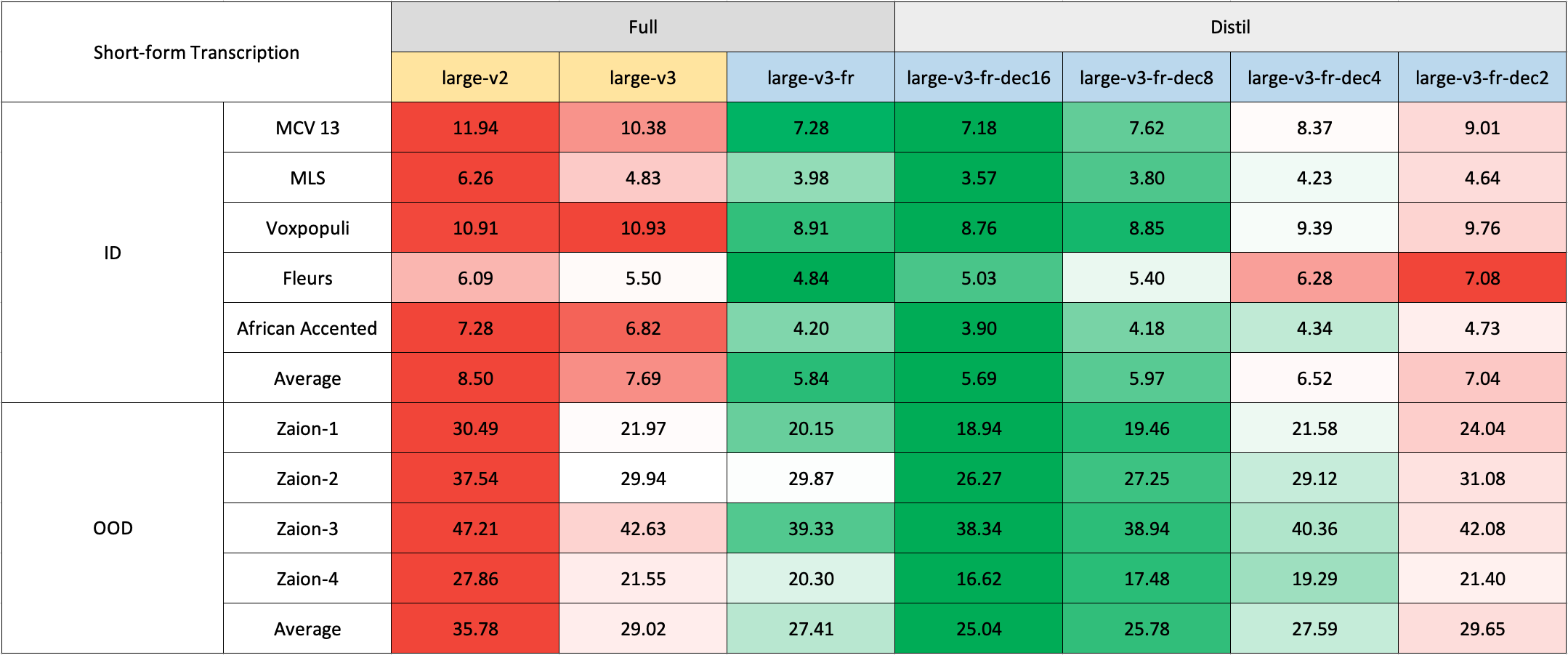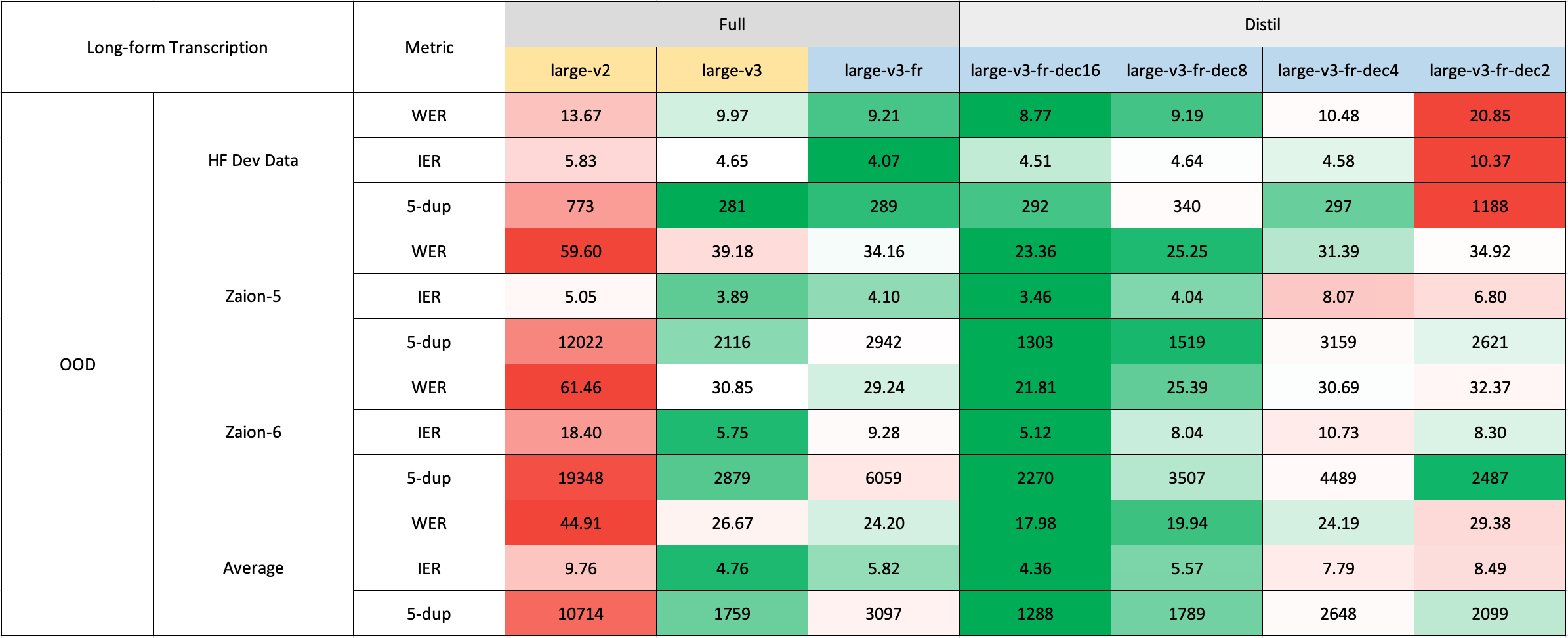Model Overview
Model Features
Model Capabilities
Use Cases
🚀 Whisper-Large-V3-French-Distil-Dec16
Whisper-Large-V3-French-Distil-Dec16 is a distilled version of the Whisper-Large-V3-French model. It reduces memory usage and inference time while maintaining performance, and can be used in various libraries.
🚀 Quick Start
This model is a series of distilled versions of Whisper-Large-V3-French. By reducing the number of decoder layers from 32 to 16, 8, 4, or 2 and distilling with a large - scale dataset (as detailed in this paper), it achieves better performance in terms of memory and speed.
The distilled variants reduce memory usage and inference time, maintain performance based on the number of retained layers, and mitigate the risk of hallucinations, especially in long - form transcriptions. They can also be combined with the original Whisper - Large - V3 - French model for speculative decoding, improving inference speed and output consistency.
This model has been converted into various formats for use in different libraries, such as transformers, openai - whisper, fasterwhisper, whisper.cpp, candle, mlx, etc.
✨ Features
- Performance Optimization: Reduces memory usage and inference time while maintaining performance and reducing hallucination risks.
- Multiple Formats: Converted into various formats for compatibility with different libraries.
- Speculative Decoding: Can be combined with the original model for faster and more consistent inference.
📚 Documentation
Table of Contents
Performance
We evaluated our model on short and long - form transcriptions, and on both in - distribution and out - of - distribution datasets for a comprehensive analysis of its accuracy, generalizability, and robustness.
Note that the reported WER is the result after converting numbers to text, removing punctuation (except for apostrophes and hyphens), and converting all characters to lowercase.
All evaluation results on public datasets can be found here.
Short - Form Transcription

Due to the lack of readily available out - of - domain (OOD) and long - form French test sets, we used internal test sets from Zaion Lab. These sets consist of human - annotated audio - transcription pairs from call center conversations, with significant background noise and domain - specific terminology.
Long - Form Transcription

The long - form transcription was run using the 🤗 Hugging Face pipeline for quicker evaluation. Audio files were segmented into 30 - second chunks and processed in parallel.
Usage
Hugging Face Pipeline
The model can be easily used with the 🤗 Hugging Face pipeline class for audio transcription.
For long - form transcription (> 30 seconds), you can activate the process by passing the chunk_length_s argument. This approach segments the audio into smaller segments, processes them in parallel, and then joins them at the strides by finding the longest common sequence. While this chunked long - form approach may have a slight performance compromise compared to OpenAI's sequential algorithm, it provides 9x faster inference speed.
import torch
from datasets import load_dataset
from transformers import AutoModelForSpeechSeq2Seq, AutoProcessor, pipeline
device = "cuda:0" if torch.cuda.is_available() else "cpu"
torch_dtype = torch.float16 if torch.cuda.is_available() else torch.float32
# Load model
model_name_or_path = "bofenghuang/whisper-large-v3-french-distil-dec16"
processor = AutoProcessor.from_pretrained(model_name_or_path)
model = AutoModelForSpeechSeq2Seq.from_pretrained(
model_name_or_path,
torch_dtype=torch_dtype,
low_cpu_mem_usage=True,
)
model.to(device)
# Init pipeline
pipe = pipeline(
"automatic-speech-recognition",
model=model,
feature_extractor=processor.feature_extractor,
tokenizer=processor.tokenizer,
torch_dtype=torch_dtype,
device=device,
# chunk_length_s=30, # for long-form transcription
max_new_tokens=128,
)
# Example audio
dataset = load_dataset("bofenghuang/asr-dummy", "fr", split="test")
sample = dataset[0]["audio"]
# Run pipeline
result = pipe(sample)
print(result["text"])
Hugging Face Low - level APIs
You can also use the 🤗 Hugging Face low - level APIs for transcription, offering more control over the process, as shown below:
import torch
from datasets import load_dataset
from transformers import AutoModelForSpeechSeq2Seq, AutoProcessor
device = "cuda:0" if torch.cuda.is_available() else "cpu"
torch_dtype = torch.float16 if torch.cuda.is_available() else torch.float32
# Load model
model_name_or_path = "bofenghuang/whisper-large-v3-french-distil-dec16"
processor = AutoProcessor.from_pretrained(model_name_or_path)
model = AutoModelForSpeechSeq2Seq.from_pretrained(
model_name_or_path,
torch_dtype=torch_dtype,
low_cpu_mem_usage=True,
)
model.to(device)
# Example audio
dataset = load_dataset("bofenghuang/asr-dummy", "fr", split="test")
sample = dataset[0]["audio"]
# Extract feautres
input_features = processor(
sample["array"], sampling_rate=sample["sampling_rate"], return_tensors="pt"
).input_features
# Generate tokens
predicted_ids = model.generate(
input_features.to(dtype=torch_dtype).to(device), max_new_tokens=128
)
# Detokenize to text
transcription = processor.batch_decode(predicted_ids, skip_special_tokens=True)[0]
print(transcription)
Speculative Decoding
Speculative decoding can be achieved using a draft model (a distilled version of Whisper). This approach guarantees the same output as using the main Whisper model alone, offers 2x faster inference speed, and only incurs a slight increase in memory overhead.
Since the distilled Whisper has the same encoder as the original, only its decoder needs to be loaded, and encoder outputs are shared between the main and draft models during inference.
Using speculative decoding with the Hugging Face pipeline is simple - just specify the assistant_model within the generation configurations.
import torch
from datasets import load_dataset
from transformers import (
AutoModelForCausalLM,
AutoModelForSpeechSeq2Seq,
AutoProcessor,
pipeline,
)
device = "cuda:0" if torch.cuda.is_available() else "cpu"
torch_dtype = torch.float16 if torch.cuda.is_available() else torch.float32
# Load model
model_name_or_path = "bofenghuang/whisper-large-v3-french"
processor = AutoProcessor.from_pretrained(model_name_or_path)
model = AutoModelForSpeechSeq2Seq.from_pretrained(
model_name_or_path,
torch_dtype=torch_dtype,
low_cpu_mem_usage=True,
)
model.to(device)
# Load draft model
assistant_model_name_or_path = "bofenghuang/whisper-large-v3-french-distil-dec2"
assistant_model = AutoModelForCausalLM.from_pretrained(
assistant_model_name_or_path,
torch_dtype=torch_dtype,
low_cpu_mem_usage=True,
)
assistant_model.to(device)
# Init pipeline
pipe = pipeline(
"automatic-speech-recognition",
model=model,
feature_extractor=processor.feature_extractor,
tokenizer=processor.tokenizer,
torch_dtype=torch_dtype,
device=device,
generate_kwargs={"assistant_model": assistant_model},
max_new_tokens=128,
)
# Example audio
dataset = load_dataset("bofenghuang/asr-dummy", "fr", split="test")
sample = dataset[0]["audio"]
# Run pipeline
result = pipe(sample)
print(result["text"])
OpenAI Whisper
You can use the sequential long - form decoding algorithm with a sliding window and temperature fallback, as described by OpenAI in their original paper.
First, install the openai - whisper package:
pip install -U openai-whisper
Then, download the converted model:
python -c "from huggingface_hub import hf_hub_download; hf_hub_download(repo_id='bofenghuang/whisper-large-v3-french-distil-dec16', filename='original_model.pt', local_dir='./models/whisper-large-v3-french-distil-dec16')"
Now, you can transcribe audio files according to the usage instructions in the repository:
import whisper
from datasets import load_dataset
# Load model
model = whisper.load_model("./models/whisper-large-v3-french-distil-dec16/original_model.pt")
# Example audio
dataset = load_dataset("bofenghuang/asr-dummy", "fr", split="test")
sample = dataset[0]["audio"]["array"].astype("float32")
# Transcribe
result = model.transcribe(sample, language="fr")
print(result["text"])
Faster Whisper
Faster Whisper is a re - implementation of OpenAI's Whisper models and the sequential long - form decoding algorithm in the CTranslate2 format.
Compared to openai - whisper, it offers up to 4x faster inference speed and consumes less memory. The model can also be quantized into int8 for better efficiency on both CPU and GPU.
First, install the faster - whisper package:
pip install faster-whisper
Then, download the model converted to the CTranslate2 format:
python -c "from huggingface_hub import snapshot_download; snapshot_download(repo_id='bofenghuang/whisper-large-v3-french-distil-dec16', local_dir='./models/whisper-large-v3-french-distil-dec16', allow_patterns='ctranslate2/*')"
Now, you can transcribe audio files according to the usage instructions in the repository:
from datasets import load_dataset
from faster_whisper import WhisperModel
# Load model
model = WhisperModel("./models/whisper-large-v3-french-distil-dec16/ctranslate2", device="cuda", compute_type="float16") # Run on GPU with FP16
# Example audio
dataset = load_dataset("bofenghuang/asr-dummy", "fr", split="test")
sample = dataset[0]["audio"]["array"].astype("float32")
segments, info = model.transcribe(sample, beam_size=5, language="fr")
for segment in segments:
print("[%.2fs -> %.2fs] %s" % (segment.start, segment.end, segment.text))
Whisper.cpp
Whisper.cpp is a re - implementation of OpenAI's Whisper models in plain C/C++ without any dependencies. It is compatible with various backends and platforms.
The model can be quantized to either 4 - bit or 5 - bit integers for better efficiency.
First, clone and build the whisper.cpp repository:
git clone https://github.com/ggerganov/whisper.cpp.git
cd whisper.cpp
Training details
The model was trained by distilling the Whisper - Large - V3 - French model, reducing the number of decoder layers and using a large - scale dataset as described in the paper.
Acknowledgements
We would like to thank all the contributors to the related projects, including but not limited to the developers of the original Whisper model, the datasets used for training and evaluation, and the open - source libraries that made this work possible.
📄 License
This project is licensed under the MIT license.
 Transformers Supports Multiple Languages
Transformers Supports Multiple Languages Transformers Supports Multiple Languages
Transformers Supports Multiple Languages